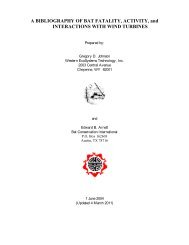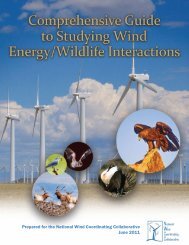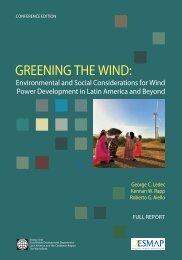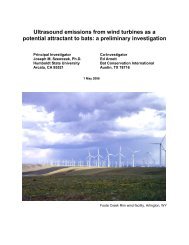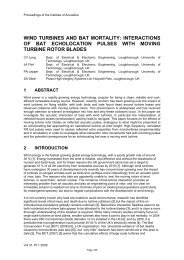Proceedings of the 2004 Bats and Wind Power Generation ...
Proceedings of the 2004 Bats and Wind Power Generation ...
Proceedings of the 2004 Bats and Wind Power Generation ...
You also want an ePaper? Increase the reach of your titles
YUMPU automatically turns print PDFs into web optimized ePapers that Google loves.
Day One — Thursday February 198:00 A.M. – 8:30 A.M. CONTINENTAL BREAKFASTWelcoming RemarksBonnie Ram, Energetics (workshop facilitator) - Introduction <strong>and</strong> Workshop PurposeBob Fritz, FPL VP <strong>of</strong> Operations – Host WelcomeAlex Hoar, U.S. Fish <strong>and</strong> Wildlife Service – Sponsors Welcome8:30 A.M. - 10:00 A.M. BACKGROUND PRESENTATIONSThe morning session will consist <strong>of</strong> several overview presentations running between 15-20 minutes with time for questions <strong>and</strong>answers. Presenters will include:R<strong>and</strong>y Hoyle – FPL Energy <strong>Wind</strong> Construction/Development, Overview <strong>of</strong> a <strong>Wind</strong> Turbine Project: Layout, Infrastructure, <strong>and</strong>OperationsMerlin Tuttle – Bat Conservation International, Background on Relevant Bat Studies in <strong>the</strong> U.S.Jessica Kerns – Appalachian Associates, Survey Methods <strong>and</strong> Findings at <strong>the</strong> Mountaineer Project in West VirginiaCharles Nicholson – TVA, Methods <strong>and</strong> Findings at Buffalo Mountain in Tennessee10:30 A.M. – NOON EXPERT PRESENTATIONSThe ten presenters will provide a brief overview <strong>of</strong> relevant knowledge. Presentations will be a maximum <strong>of</strong> 15 minutes. This sessionwill allow for questions <strong>and</strong> answers <strong>and</strong> brainstorming.Bill Evans puts wind power into broad conservation perspective, discusses projected numbers <strong>and</strong> locations <strong>of</strong> wind turbines innor<strong>the</strong>ast, what triggers bird migrations, <strong>and</strong> wea<strong>the</strong>r <strong>and</strong> topographic factors that increase risks.Ron Larkin introduces radar as a tool for observing flying animals <strong>and</strong> describes examples <strong>of</strong> field research with bird kills at talltowers <strong>and</strong> skyscrapers.Robert Barclay presents background on bat/wind power experience relative to topography in western Canada <strong>and</strong> summarizes hisobservations on timing <strong>and</strong> nightly variation among migratory bats.<strong>Bats</strong> <strong>and</strong> <strong>Wind</strong> <strong>Power</strong> <strong>Generation</strong> Technical Workshop A-2



